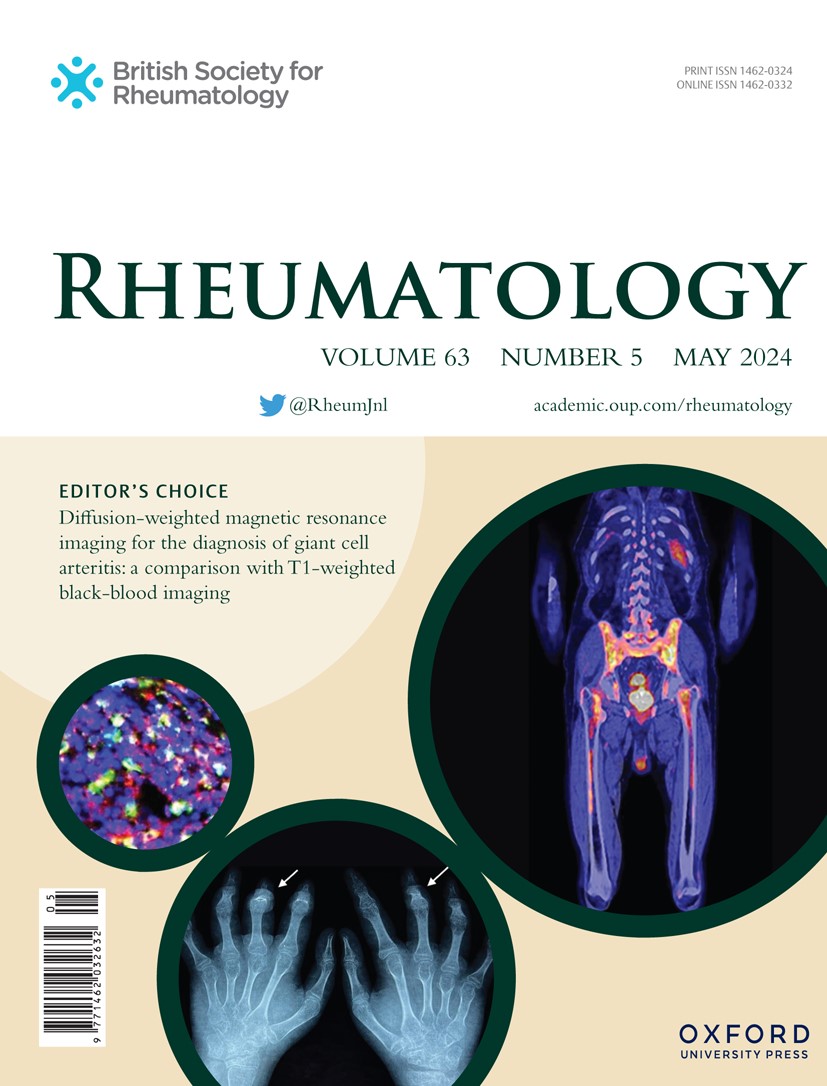Differences in spinal structural lesions between patients with early axSpA and non-axSpA chronic back pain: 2-year SPACE cohort results
IF 4.4
2区 医学
Q1 RHEUMATOLOGY
引用次数: 0
Abstract
Objectives To compare spinal structural lesions on radiography and magnetic resonance imaging (MRI) over 2 years, between patients with early axial spondyloarthritis (axSpA) and non-axSpA chronic back pain. Methods Patients from the SPACE cohort with available radiography or MRI at both baseline and 2-year were included. Spinal lesions on radiography were assessed by the modified Stoke Ankylosing Spondylitis Spine Score (mSASSS), corner MRI lesions by the modified Canada-Denmark scoring system. Baseline spinal structural lesions and 2-year changes were compared between axSpA and non-axSpA. Generalized Estimating Equations were used to assess the change over 2-year, adjusting for age, sex, NSAID-use, and diagnosis. Results Radiography data from 318 patients (67% axSpA), MRI data from 351 patients (69% axSpA) were included. At baseline, the mean (SD) mSASSS was 0.6 (1.1) for both axSpA and non-axSpA. Over 2 years, mSASSS progression was minimal (0.01 units/year) in both groups. On MRI, axSpA patients had a mean of 1.4 (2.9) total structural lesions compared with 0.7 (2) in non-axSpA at baseline (p= 0.12). Significant 2Y increase in structural lesions [0.5 (1.8)] was mainly due to fat lesions [0.5 (1.6)] in axSpA. On MRI, fat lesions changed at a rate of 0.16 units/year in axSpA (p= 0.002), and -0.02 units/year in non-axSpA (p= 0.70). Conclusion Over 2 years, spinal structural damage typical for axSpA progressed minimally on radiography in axSpA and non-axSpA. On MRI, axSpA showed a significant increase in fat lesions, while non-axSpA had no progression. Fat lesions may be important to assess spinal changes from early disease onwards.早期axSpA和非axSpA慢性背痛患者脊柱结构病变的差异:2年SPACE队列结果
目的比较早期中轴性脊柱炎(axSpA)和非axSpA型慢性背痛患者2年内脊柱结构病变的影像学和磁共振成像(MRI)。方法纳入来自SPACE队列的基线和2年的x线或MRI患者。影像学上的脊柱病变采用改良的斯托克强直性脊柱炎脊柱评分(mSASSS)进行评估,拐角MRI病变采用改良的加拿大-丹麦评分系统进行评估。基线脊柱结构病变和2年变化在axSpA和非axSpA之间进行比较。使用广义估计方程评估2年内的变化,调整年龄、性别、非甾体抗炎药使用和诊断。结果纳入318例(67%)患者的x线资料,351例(69%)患者的MRI资料。基线时,axSpA和非axSpA的平均(SD) mSASSS为0.6(1.1)。2年后,两组的mSASSS进展最小(0.01单位/年)。在MRI上,基线时,axSpA患者平均有1.4(2.9)个总结构性病变,而非axSpA患者为0.7(2)个(p= 0.12)。axSpA中结构性病变[0.5(1.8)]的显著增加主要是由于脂肪病变[0.5(1.6)]。在MRI上,axSpA组的脂肪病变以0.16单位/年的速率变化(p= 0.002),非axSpA组的脂肪病变以-0.02单位/年的速率变化(p= 0.70)。结论在2年多的时间里,axSpA和非axSpA的脊柱结构损伤进展最小。在MRI上,axSpA显示脂肪病变明显增加,而非axSpA没有进展。从疾病早期开始,脂肪病变可能是评估脊柱变化的重要因素。
本文章由计算机程序翻译,如有差异,请以英文原文为准。
求助全文
约1分钟内获得全文
求助全文
来源期刊

Rheumatology
医学-风湿病学
CiteScore
9.40
自引率
7.30%
发文量
1091
审稿时长
2 months
期刊介绍:
Rheumatology strives to support research and discovery by publishing the highest quality original scientific papers with a focus on basic, clinical and translational research. The journal’s subject areas cover a wide range of paediatric and adult rheumatological conditions from an international perspective. It is an official journal of the British Society for Rheumatology, published by Oxford University Press.
Rheumatology publishes original articles, reviews, editorials, guidelines, concise reports, meta-analyses, original case reports, clinical vignettes, letters and matters arising from published material. The journal takes pride in serving the global rheumatology community, with a focus on high societal impact in the form of podcasts, videos and extended social media presence, and utilizing metrics such as Altmetric. Keep up to date by following the journal on Twitter @RheumJnl.
 求助内容:
求助内容: 应助结果提醒方式:
应助结果提醒方式:


